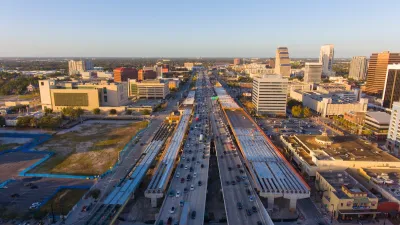What does a successfully multi-modal and livable street look like? There are examples all over the world, if you're paying attention.

Jeff Speck writes for CityLab about the next front in the ongoing contest to control the design of streets. On one side are cars and traffic engineers, but the latter of those two have ceded ground in recent years to pedestrians and placemaking.
Noting recent successes, Speck asks the questions: "What is the next urgent battle to be fought in the name of more walkable, livable streets and communities?" And, "what if there were one category that managed to include all the others?"
Speck answers these inquiries affirmatively, noting the importance of models, otherwise known as paying attention to precedent. Speck even has a case study with which to make his point, with the example of Lowell, Massachusetts' plan to transform a below-grade highway, with an elevated traffic circle, into a boulevard. Grant Welker reported on the details of the proposed redesign for the Lowell Sun. Speck critiques the current plan by appealing to precedents.
While there exist a growing number of locations in America with street configurations like this one, it is impossible to name one with street life. Swoopy configurations like this design are found mostly in suburban drive-only locations out by the mall, not in cities. If no attractive place can be found with a similar configuration, then a design should not pass the street-planning smell test.
To counter the current proposal, Speck chooses his own precedent—as set by The Boulevard Book by Alan Jacobs, which laid out the fundamental ingredients for a boulevard that both moves cars and provides a walkable urban setting.
FULL STORY: The Simplest Way to Avoid Bad Street Design: Copy the Ones That Work

Alabama: Trump Terminates Settlements for Black Communities Harmed By Raw Sewage
Trump deemed the landmark civil rights agreement “illegal DEI and environmental justice policy.”

Study: Maui’s Plan to Convert Vacation Rentals to Long-Term Housing Could Cause Nearly $1 Billion Economic Loss
The plan would reduce visitor accommodation by 25% resulting in 1,900 jobs lost.

Planetizen Federal Action Tracker
A weekly monitor of how Trump’s orders and actions are impacting planners and planning in America.

Wind Energy on the Rise Despite Federal Policy Reversal
The Trump administration is revoking federal support for renewable energy, but demand for new projects continues unabated.

Passengers Flock to Caltrain After Electrification
The new electric trains are running faster and more reliably, leading to strong ridership growth on the Bay Area rail system.

Texas Churches Rally Behind ‘Yes in God’s Back Yard’ Legislation
Religious leaders want the state to reduce zoning regulations to streamline leasing church-owned land to housing developers.
Urban Design for Planners 1: Software Tools
This six-course series explores essential urban design concepts using open source software and equips planners with the tools they need to participate fully in the urban design process.
Planning for Universal Design
Learn the tools for implementing Universal Design in planning regulations.
Caltrans
Smith Gee Studio
Institute for Housing and Urban Development Studies (IHS)
City of Grandview
Harvard GSD Executive Education
Toledo-Lucas County Plan Commissions
Salt Lake City
NYU Wagner Graduate School of Public Service




























